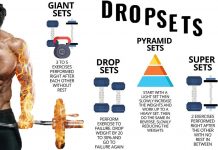🔥 Bar Placement & Feet Pressure For Squats 👇

✅ There are two things to remember about the bar placement and feet pressure during your squat.
1. 🚨 The bar should be over the center of your feet throughout the entire lift.
[wp_ad_camp_2]
✅ This helps you keep your balance and utilize your quads more.
I recommend filming yourself from the side to see where it is currently at.
2. 🚨 The pressure at the feet should be evenly distributed.
A tip I like to use is the “tripod.” You want to basically create a tripod with your feet (a very stable stance) by driving your heels and pressing down with your big toe and small toe simultaneously.
This will help you keep your balance and exert the most power.
🚨 How deep should you squat?
💪 Let’s start with how your hands should be on the bar
[wp_ad_camp_4]
- Having the proper forearm angle during the squat can prevent pain in your elbows, shoulders or wrists.
- Having the forearm vertical to the floor will compress your wrists, bend them back and cause wrist/elbow pain.
- Having them raised too high, on the other hand, will cause shoulder pain and upper-back rounding.
- The optimal angle for the forearm is too raise it until it is in line with your torso at the bottom of your squat.
- This will prevent any unnecessary pain during your squat!

✅ A lot of people seem to have their own definition of a squat depth, but I’m here to break it to those that their squats are half-squats.
[wp_ad_camp_5]
The textbook squat depth is to have the crease at the hip (where your upper thigh and hip join together) be slightly below the top of your kneecap.
Anything above is not a squat, but anything below is perfectly fine. You may not be able to squat the most weight if you go deeper, but you will make that up with increased hypertrophy.

















































